USA 2002, March / April
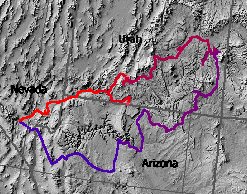
|
This trip wasn't exactly my idea. In summer 2001, Claudia, my sister,
called me and told me about the Wave. The Wave is a sandstone formation
in the Paria Canyon / Vermillion Cliffs Wilderness area. She had seen
pictures of it somewhere and wanted to go there. Unfortunately the
access to the area is somewhat restricted. Basically, only ten visitors
are allowed per day and you have to apply for permits six months before
the trip. In addition, the permits sell out fairly fast, so it's a good
idea to get them within half an hour after they get available.
Essentially the call went along the lines of "I'm not quite sure whether
I understand the instructions on their web site correctly and I basically
have just one or two shots at getting the permits and I don't want to
spoil my chances by some stupid oversight or misinterpretation, so
could you please take care of it."
|
So I read the relevant web site and lots of other stuff about the Wave
and figured out how to have the best chance of getting the permits for
the date she wanted. And at some point the discussion with my sister
turned towards "you have to admit that the Wave looks interesting and
we got room in the rented car anyway, so why don't you just tag along
on the trip?" Since I didn't have any specific travel plans for 2002
anyway, it seemed like a good idea. So while I had a lot of input on
the specifics of the journey, the basic idea came from Claudia and
Roberto (my sister and her husband).
We had to wait a while until the deadline came around when we could
apply for the Wave permits, but then we didn't have any problems and
we got the permits for our preferred day. After that we could start
to plan the rest of the trip. It boiled down to a clockwise tour
around the Grand Canyon, hitting a lot of National Parks and
State Parks.
I joined Claudia and Roberto in Las Vegas. They had started their
vacation about a week earlier, starting in San Francisco, and driving
down to Los Angeles, before flying to Las Vegas. Since I did a similar
tour two years earlier
(see here)
I didn't want to repeat that, so I just participated in
the second part of the USA travel.
The first stop was in the Valley of Fire State Park, which is
sort of on the way between Las Vegas and Zion National Park.
Most travel guides seem to skimp over this park, eager to
get to the main attractions, but the Valley of Fire
is well worth a stop. It is also a very fitting first stop,
since it's a good overture or preview of coming attractions
for the other parks. It has got nice looking red stone formations,
with neat little holes to sit in and gaps and pits to crawl
and climb in and out of, it has a bit of a slot canyon, an
arch, strangely shaped rock formations tease the imagination and
petroglyphs, all in a nice, small, and easy to handle size.

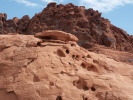
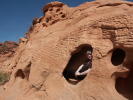
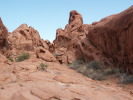
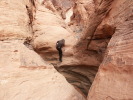
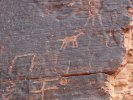
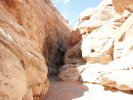
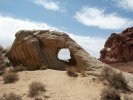
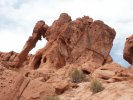
We spent the night in a cabin in the Zion National Park, but since
we were longer than expected in the Valley of Fire, we just had time
for a short walk before sunset. Since we were off to the Wave the
next day, there also wasn't much time to for sightseeing the next
morning, just time for a quick look around at the top of the
mountains lit by the early light of sunrise and the porcupines
sitting in their trees.
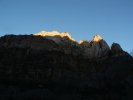
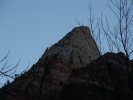
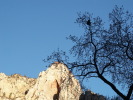
So onwards toward the main attraction: The Wave.
The Wave itself is a rather small area in the Paria Canyon area and it's about
three miles away from the trailhead. It's not a difficult hike, but it crosses
a variety of terrain, from deep sand to slickrock, it was a warm day, we didn't
quite know what to expect, none of us is an experienced hiker and none of
us is a doing any sports or fitness stuff either, so it was a bit strenuous
for us, but not really hard or difficult to do. I still wouldn't like
to do it in full summer heat, but then I'm more of a glacier and iceberg
person anyway...
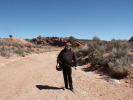
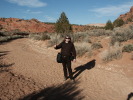
We made some 'before' and 'after' pictures at the trailhead, but they show
little difference, so the hike obviously wasn't that hard.
Here are a couple of pictures features along the way to the Wave.
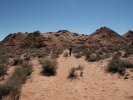
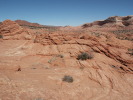
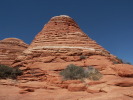
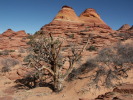
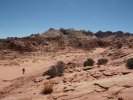
As for the Wave itself, I was rather sceptical at first. I wasn't quite sure
whether it was as impressive as everyone who'd been there has been saying,
or whether people just were impressed because it's so difficult to get
there and that alone makes it special. Since I usually don't subscribe
to the theory that things are better if you had to work harder for them
(I'm perfectly willing to go to a good restaurant and order a meal, and
I don't think that some mushrooms or berries collected in the woods make
a more delicious dinner, just because I picked them myself), I wasn't
quite sure whether I would really like the Wave.
As it turned out, it was rather odd. While the Wave looks really
amazing on professional photographs (and these great images are
the basic reason why people are drawn to this place), up close
it's a bit like a film set. There is one point of view, from which,
using the right lighting, the right filters, the right lens and
the right film, it looks good, beautiful and 'larger than life'.
This is the typical picture of the Wave that you see everywhere.
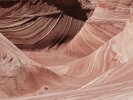
Standing somewhere else is also like standing on a film set. Things
somehow don't look quite right, perspectives don't match the way they
should and everything looks slightly distorted. Which, surprisingly,
makes it fun to be there in a way I didn't suspect, but also accounts
for about a hundred pictures I made, which all look somewhat dull and
it took me some time afterwards to figure out why. Abandoning the
'film set' metaphor, a good comparison might also be a
'house of mirrors'. Slightly distorted looking people in mirrors
don't look particularly interesting on photographs, but moving
around in such an environment feels strange, since the way the
views change aren't quite what you expect. It's similar in the
Wave, especially in the midday sun, where you don't have many shadows,
which give the overall shape away, so it is not immediately obvious
whether a curve in the sandstone texture is actually a curve in
the texture or a curve in the sandstone. So when you move around,
it feels slightly unreal. (Take a some 3D editing
software. Build a swirly shape. But on a swirly texture. Light
with ambient light. Move slowly through the shape. See what I mean?
No? Ok, then go to the Wave and have a look...)
As you can tell from the increasingly confusing similes I'm using
to talk about the Wave: It's difficult to describe.
It is interesting to go there and it's an exciting place to be
in (especially if you're lucky and have no other tourists around),
but not at all for the reasons I expected.
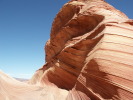
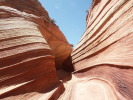
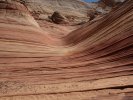
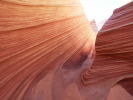
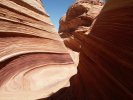
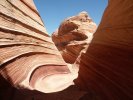
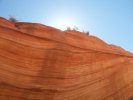
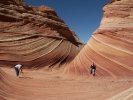
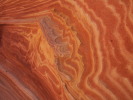
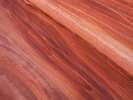
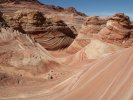
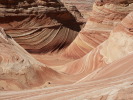
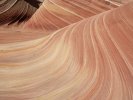
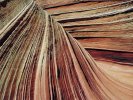
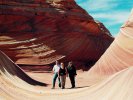
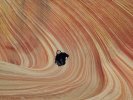
(Btw., the last picture, which looks a bit like me toboggan down
the Wave gave me an idea for a picture I'd like to see: Someone
riding a surfboard on the Wave. So if somebody feels like carrying
a surfboard through miles of desert, just for a goofy looking
photograph, please let me see a copy of the picture. Thanks!)
Next stop was Bryce Canyon, which is a nice diorama. All these
little spires and turrets give the place a bit of a look of
a hundred fossilized Disneylands, sort of an elephant graveyard
for fairytale castles. Terry Pratchett described
a structure once as something build by an architect who had heard
of Gormenghast, but didn't have the budget. Bryce Canyon looks
like someone had heard about sandcastles who had way too much
money to burn...
Like Grand Canyon, Bryce Canyon feels a bit like a museum
exhibit. Unless you are serious about hiking (as in nine miles,
1700 feet of ascent/descent type of walks), there is a distinct
separation between viewing area and attraction area. You drive
along the rim, stop at the viewpoints, look down into the valley,
are impressed, take a few pictures, and go back to the car.
So it's a bit of a "look, don't touch" feel to the place, like
in older museums, before "hand on" experiences became popular.
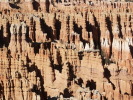
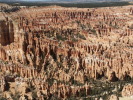
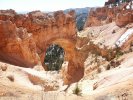
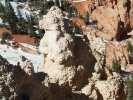
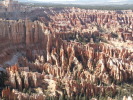
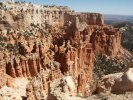

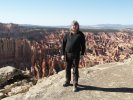
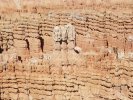
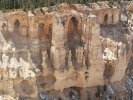
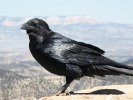
Though I had been on an ATV once, that
was only for a short round on a marked track on snow. Since they offered
ATV tours near Bryce Canyon, I went on a three hour tour, to get a bit
more ATV driving. This was more fun than expected, even though it was
a guided tour, which usually means you can't fool around with the vehicle
as much as you want to. But I managed to get to be last in line, which
is always convenient, since this allows you to fall back a bit and
then do a bit of speeding to catch up. But the two surprisingly good bits
were the fact that helmets are not required (even though everyone else
was wearing them, but it's more fun to let your hair fly in the wind) and,
more importantly, it was in a nice landscape.
Since ATVs are kind of noisy, I expected them to be restricted to rather
dull areas, where nobody else wants to go. Fortunately, there are enough
fine places close to Bryce Canyon, so that even noisy, dirty and smelly
activities get to enjoy great views. The ATV track was in the Casto Canyon
area, and quite varied. Gravel roads, dry river beds, sand tracks,
patches of mud and even a bit of snow at the higher end (at the highest
point, we were about 1500 feet higher than when we started).
A way time to spend the early afternoon.
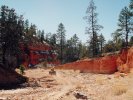
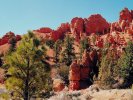
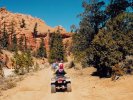
Later that afternoon we went on a helicopter ride. Though I'm usually quite
fond of helicopter flights, this one was less spectacular than expected.
Sure, part of the reason was that it got fairly windy that afternoon and
some movements of the helicopter were a bit unusual, the real reason seems
to lie somewhere else. Usually on a sightseeing flight, you get
another perspective on things. For example, you stand in the mist
right next to Niagara Falls and listen to the roar of the waterfall
and then you watch it from a helicopter and see the overall shape and
the larger picture. In Bryce Canyon, you already see the larger picture
from the normal viewpoints. You don't have the "close up" view and then
the "bird's eye view". What you basically get is the "looking down on
the rock formations from one side" followed by the "looking down on
the rock formations from the other side" experience. Yes, you get
to see more than you would see if you only do the rim drive, but
it's not significantly different.
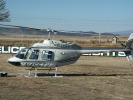
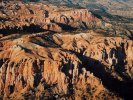
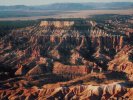
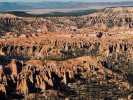
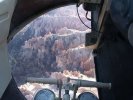
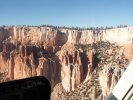
Next day we drove onwards toward Moab, with short stops along the
way at Capitol Reef National Park and other nice places.
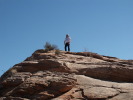

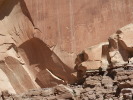
But the main attraction on the way was Goblin Valley.
Similar to the Valley of Fire, Goblin Valley turned out to be
much more fun than expected. Mostly ignored by older travel
guides, it is seen by more visitors now, partly due to the
fact that the old seven mile gravel road has given way
to a paved road, and partly because it was featured
prominently in the movie 'Galaxy Quest'.
Goblin Valley is a bit like a miniature playground version of Bryce Canyon.
Odd rock and stone formations abound, but they are small enough to
walk around and to climb on. Lots of weird shapes that allow you
to speculate what they could represent. All conveniently self-contained
in a small valley with flat ground. Recommended.
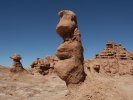
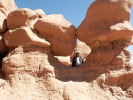
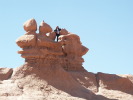
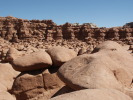
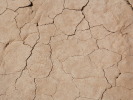
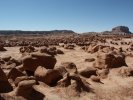
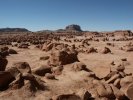
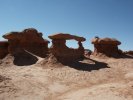
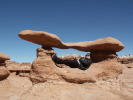
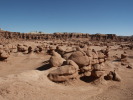
The base for the next two days was the most luxurious one on the
trip (and that includes the Luxor in Las Vegas). The Sorrel River Ranch
is located about 17 miles east of Moab, right next to the Colorado river,
with great views in all directions (and a good restaurant for dinner).
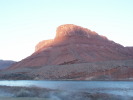
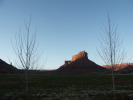
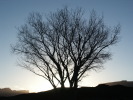

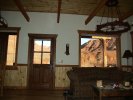
From there we did a trip to the Island in the Sky part of the Canyonlands
National Park, which was the only real disappointment on the trip. There's
basically just one good view in that part of the park and you have to drive
about 40 miles to see it.
Here it is:
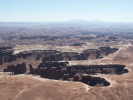
Ok, now you've seen it. Unless you want to go to Canyonlands National Park
for the hiking opportunities, you can now skip that part of the trip and
go directly to Arches National Park.
Of the National Parks on this trip, this one is clearly my favourite.
That's partly because I just like arches (don't know why, maybe because
they are such unlikely geological structures) and this park has a good
selection of them. But it also helps that the park has a nice mixture
of drives, short hikes, long hikes, flat hikes, climbing hikes, wide
views and narrow valleys, so it allows more tailoring of activities
to personal taste than other parks.
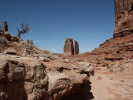
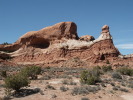
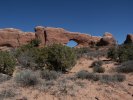
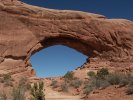
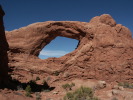
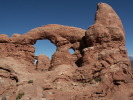
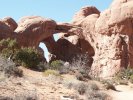
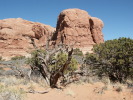
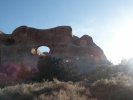
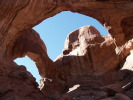
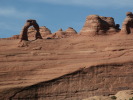
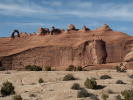
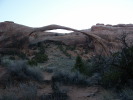
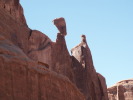
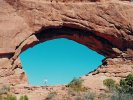

After that we were westward bound again, heading for Page at Lake Powell and
passing the Natural Bridges National Monument, the steep road down from
Cedar Mesa, the Goosenecks of the San Juan River and Monument Valley.
(Two remarks: 1) On the way from the Sorrel River Ranch to Moab, the
police was setting up street block and a car painted with a large
Union Jack and the licence plate "Shaguar" was standing at the side
of the road. So you can probably expect parts of Austin Powers III
to be filmed around here. 2) The stone bridges in the Natural Bridges
National Monument are a bit like a large scale optical illusion.
Especially at the first one (Sipapu Bridge), we walked to the viewpoint,
looked towards the bridge and didn't see it at first. Since arches
(or natural bridges) are fairly rare, the brain seems to interpret
a bright roundish area against a darker rockface as a lit bolder
that is blocking the view instead of a hole through the dark rock.
The effect is especially noticeable in the first picture.)
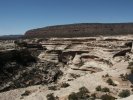
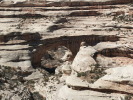
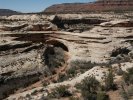
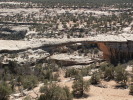
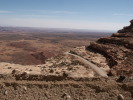
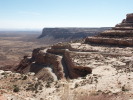
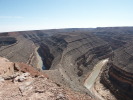
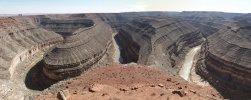
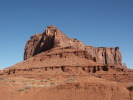

The photographic highlight of the tour was without any doubt Antelope Canyon,
near Page. It's just a short slot canyon, but it has incredibly good looking
sandstone formations and photographs well from almost every position and
angle. Truly a photographers dream (if he brought his tripod as we did -
exposure times are about two to ten seconds). Basic rule of photography seems
to be: Point your camera anywhere, look at the exposure time at the camera,
and make three shots; one at the exposure time the camera thinks is right,
one at double the exposure time and one in between. [Though longer exposures
seem to be mainly for those using film. The shots on my digital camera usually
looked better at the exposure time the camera estimated, on my SLR camera
the longer exposures tend to look better. Anyway, just shoot a lot of pictures
and decide what's best later...]
There are a few tours that go to Antelope Canyon and most of them last
about ninety minutes with an hour in the slot canyon. There are also
'photographer tours' which last three hours and are much better if you
want to do any serious photographing at all. (Actually the title is
sort of misleading. The great thing about the 'photographer tours' is
that they aren't really tours. The guide walks with you once through
the canyon, pointing out good photo positions and mentioning at what
times sun rays will strike the floors in what area) and then just
leaves you alone for two hours, before he picks you up again
with another tour. No history, no hype, no geology lessons, just
getting people in there and then out of the way. Great tour!)
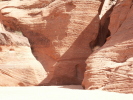
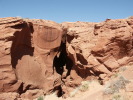
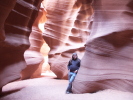
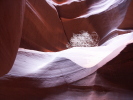
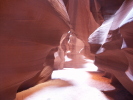
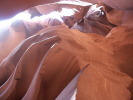
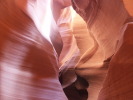
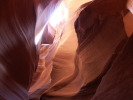
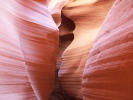
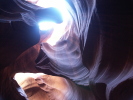
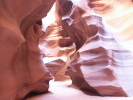







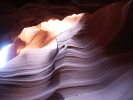
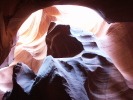





Another type of vehicle I had never used before was a jet ski. I thought about
using one in Eilat during my Israel vacation
the previous year, but with the submarine ride and the diving with dolphins,
I didn't get around to actually doing it. (They also don't let you just rent
one of these things. You are supposed to sit as a passenger on the jet ski
with an experienced person driving it, which probably takes out all of the fun.)
At Lake Powell, you can just show up, rent a jet ski (or personal water craft [PWC]
as they are called now) and a wet suit and sign a handful of forms that you've
read the instructions, seen the safety video and are responsible for everything that
might happen to you, the craft and anything else, probably including the JFK
assassination and the ultimate fate of the universe.
But after that, you can just climb onto the jet ski and have a go.
(Or, as the brochure had it: Go far. Go fast.)
Short summary: These things are fun!
I didn't have that much fun on a vehicle since riding a
snowmobile in Sweden and the
hovercraft in England.
Actually the jet ski ride was very similar to the snowmobile ride.
Both are fairly simple to steer (unlike the hovercraft), I did
ride both on a lake and it wasn't a guided tour or fixed track,
so I could just take that thing and fool around with it for
about two hours. And Lake Powell was perfect for this. This early
in the season, the lake was virtually empty, so I didn't have to
worry too much about crashing into other boats or jet skis. There
were about three or four powerboats coming in to the marina while
I was out with the jet ski, but they were easy to see from a long
way off and easily avoided. And it was slightly windy, so the
surface of the lake wasn't completely flat, so there was a bit of
bumpiness to the ride, without it ever being scary or dangerous,
so it was perfect for a first-timer like me. And Lake Powell has
these steep rockfaces on the side opposite the marina, so it's
not like driving through a dull, flat scenery, but it's a bit like
water based sightseeing. But mostly it's just pure, silly fun to
rush across the lake.
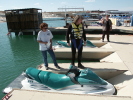
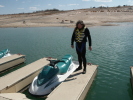
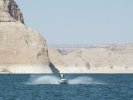
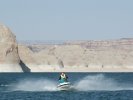
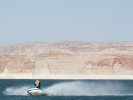
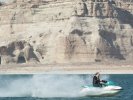
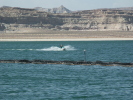
Last National Park on the trip was Grand Canyon, where we went to Hopi Point
to watch the sunset, something my sister and I also did on our first trip
to the USA, fourteen years earlier. Of course, the sunset wasn't as glorious
as it was back then. (No, that's not just "everything was better back then"
nostalgia. I dug out the old pictures and that sunset did look better.
But that was actually because it was much cloudier then, which gave the
sunset a much stronger reddish tint and in turn the canyon a deeper red
glow than we got this time due to the very good weather during the week.)
But basically it shows that it's a good idea not to revisit places
you once liked. Don't spoil enjoyable memories...
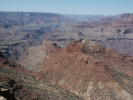
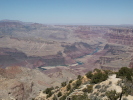

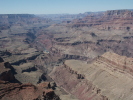
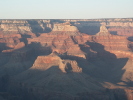
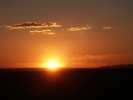
The last thing to do was to head back to Las Vegas and fly home.
We went via Route 66. This is a place where even nostalgia has
gone out of style. Anything original along the route has long
gone, but even the 'restored in original style' places have
vanished. The 'old style gas station' wasn't one of the few things
we found along the route, it was the only one. (Fortunately, none
of us is old enough that Route 66 is a trip down memory lane in
any conceivable way, but if your dreams are based on 50's nostalgia,
buy a coffeetable book and stay away from the Route 66 of today...)
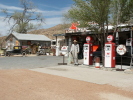
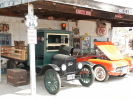
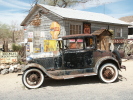
Finally back in Vegas, where we stayed the last night in the Luxor, looking
out towards Excalibur, before flying back home. (And I won't make any excuses
for the pictures. It was the last day of the vacation and if you can't
do silly, touristy things in Las Vegas, where else? [And I was sober
when these pictures were taken.])
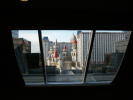

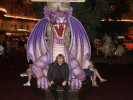
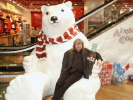
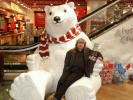
In the evening we went to the show of the Blue Man Group. Interesting
mixture of mime show, percussion show, multimedia spectacle and
industrial strength paper streamers. Oddly enough, my sister had already
seen part of the show. Some time ago, she did see a show by
a group called "Creatures" in a little theatre in Cologne, Germany.
There was no information about the background of these "Creatures"
or previous or future engagements. Also, the show was fairly big
and professional and slightly at odds with the size of the theatre
(about 50 seats or so). So unless "Creatures" is a sort of
"Blue Man Group" bootleg version (which seems unlikely), Claudia
has probably seen a sort of "test screening" of parts of the
show of the Blue Man Group under a fake name.
The only thing left to do on the next day was to get to the
airport and fly home. At least for me, the airport had a little
presentation of "things to come" in the form of a mural depicting
landmarks from Berlin. At the airport they also had a number
of sculptures of desert creatures, among which I liked the
lizard best.
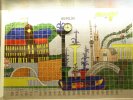
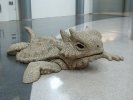

Back to other travels






















































































































































